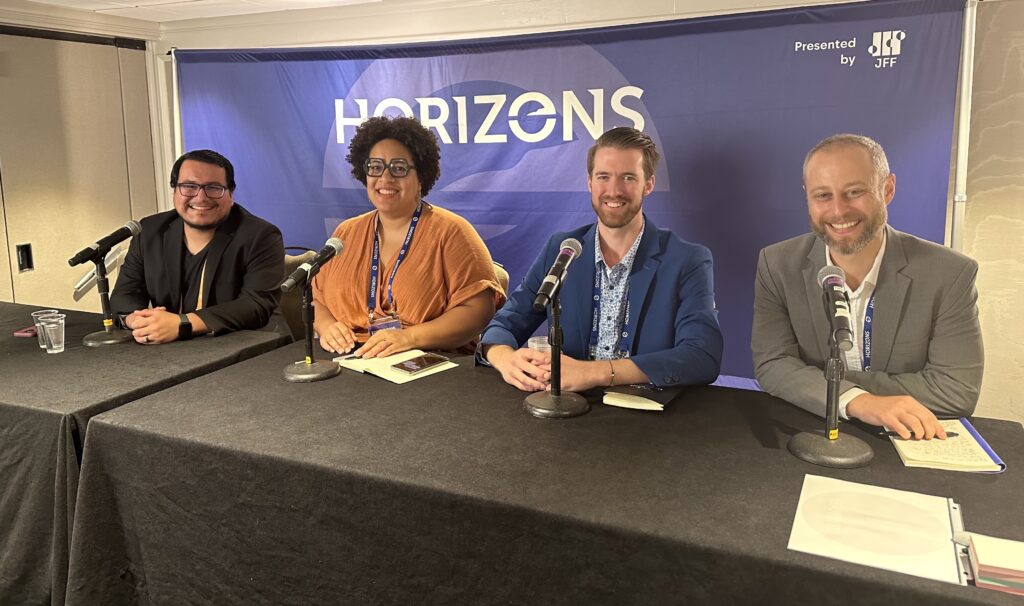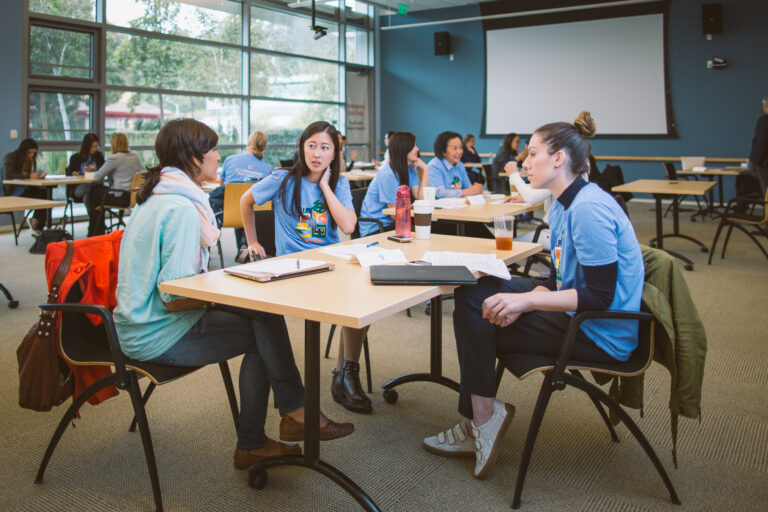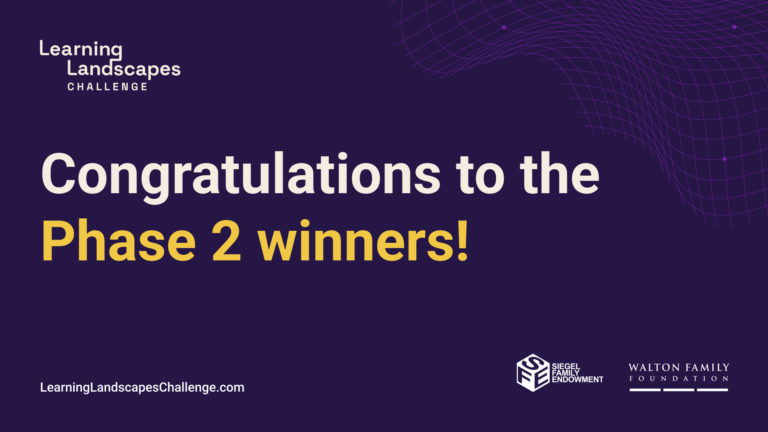
Skills-based hiring, apprenticeships, and innovative finance are making progress, but work remains to be done in equity and narrative change.
In today’s rapidly evolving job market, access to affordable higher education and equitable workforce opportunities are crucial for students, particularly those from historically excluded and underrepresented backgrounds. Our focus on innovative finance options and work-based learning programs stems from our commitment to creating an equitable innovation economy, one that enables all people and their communities to achieve economic prosperity. While progress has been made in creating affordable education and diversifying apprenticeships, it is important to analyze how they are having an impact on equity and the students most in need. It’s with this frame that members of our team attended Jobs for the Future’s (JFF) Horizons conference last week.
Siegel Panel Recap: Student Perspectives on Innovative Finance
Our Executive Director Katy Knight moderated a panel entitled “Student Perspectives on Innovative Finance,” in which former students, Ernesto Gonzales and Joey Rebbe, spoke about their experiences leveraging income share agreements (ISAs) to finance their education . Ethan Pollack, Senior Director of the Financing the Future initiative at JFF rounded out the panel with his lens on the field’s latest research and trends. The panel featured a candid conversation about their original motivations, frustrations, and outstanding questions, and closed with student reflections on how they might do things differently given what they experienced.
A key takeaway from the students was to “read the fine print” and be sure that you’re pursuing a financing structure that matches your needs and what you expect to get from the program. Furthermore, careful attention should be paid between pursuing an ISA financing option for accredited vs non-accredited programs; while accredited programs have been certified through a third-party process, unaccredited programs can be a bit of a “wild west.” In other words, quality can vary greatly between unaccredited programs. Prospective students will need to conduct due diligence to evaluate the quality of the program they’re signing up for – a point that some may not yet be fully aware of. (NOTE: Ernesto earned his education through an accredited community college, and Joey through a popular coding bootcamp).
The students also highlighted the dearth of financing options available to students of color overall as compared to more resourced, white students. “When you don’t have a support system, or the system doesn’t support you, especially as a student of color, you have to take a bet on yourself,” said Ernesto.
Below are our team’s top takeaways from the overall conference.
Balance Loan Terms with Cultural Norms, Especially for Historically Marginalized Students
One of the driving forces behind why many students of color, especially those who have been historically excluded or marginalized, seek to leverage innovative financing tools and apprenticeships is their desire to give back and pave the way for future generations. While this commitment to providing for the next generation is commendable, we must ensure that these programs do not take advantage of students’ charitable intentions, such as the desire to uplift one’s community. For example, many programs claim that 100% of student repayments are redistributed to educate future students; however, this is not always the case, as many ISAs are structured to prioritize repayment to investors. ISA claims of “paying it forward” should only be made if the financing obligation is indeed structured around fund redistribution to students. It is essential to ensure that the structure of financing agreements empower students without perpetuating exploitation or creating burdensome obligations.
Apprenticeships Can Drive Workforce Equity – If We Design Them To Do So
Work-based learning, such as apprenticeships, has proven to produce strong results for both workers and employers. Apprenticeships in the US are on the rise, with new apprenticeships emerging rapidly, developing across occupations and industries, and creating more diverse talent pipelines. However, despite growing over time, women’s enrollment in registered apprenticeship programs does not reflect their share of the working population. Current statistics reveal that while women make up about half of the national labor force, 14% of active apprentices are women. Moreover, for apprenticeships to live up to their promise, we have to design them in ways that increase access to these opportunities and holistically address the apprenticeship experience. Inclusive apprenticeship programs, particularly as apprenticeships continue to expand into new roles and fields, will be essential in driving workforce equity.
A Narrative Shift to Skills-based Hiring is Underway, but Still Needs Support
Skills-based hiring and hiring via more STARs (Skilled Through Alternate Routes) can add over 70M capable people to the workforce and would be a big boost to workforce equity. Apprenticeships continue to gain momentum, and are being explored in vital, growing sectors of the economy. Community colleges provide tremendous benefits to local economies, with one recent study showing a cluster of schools returning $12 in societal gains for every $1 spent, and can be particularly effective when engaging local businesses in program design. And yet – none of these facts alone is enough to induce a large-scale shift in how employers and employees alike think about workforce programs. Creating a more inclusive and equitable workforce requires a narrative shift that challenges the dominant paradigm and biases, though that shift will not happen on its own. That’s why we continue to amplify the stories of successful programs that are improving skill development, opening new routes for hiring, and producing quality job placement for those who have been systematically shut out of good jobs in the past.
In Conclusion
As we strive for equitable access to education and workforce opportunities, it is essential to interrogate how innovative finance, work-based learning, and cultural norms play an intersecting role. While progress has been made, there is still work to be done to ensure that these mechanisms and programs empower students of color without exploiting their cultural values. By prioritizing narrative shifts, removing barriers to apprenticeships for students who come from historically marginalized populations and in emerging industries, and promoting skills-based hiring, we can create a more inclusive and equitable workforce that benefits individuals, communities, and society as a whole.
This post is based on the key takeaways and notes from members of Siegel’s Grantmaking Team who attended the conference: Ali Chin, Joshua Elder, and Evan Trout.
A first draft of this post was generated using ChatGPT with the input criteria: “Can you write a blog post organized by three takeaways based on these notes :…?”





